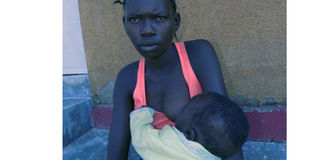Trials of 14-year-old mother

Joyce Namilo breastfeeds her nine-month baby. Photo by joseph kato.
Joyce Namilo stares into space as she breast feeds her nine-month-old baby.
At 14 years, she is the youngest among dozens of women attending a community dialogue on child marriage and teenage pregnancies at Mourita Sub-county, Nakapiripirit District, supported by United Nations Population Fund (UNFPA) Uganda through the Government of Uganda 8th Country Programme.
She has no trace of the father of her child nor his relatives, who she met him through two mutual friends at a village bar.
Her friends just like her, had dropped out school to work at the drinking joint in Nakapiripirit Town.
“He was dark skinned and short. I had never met him or seen him anywhere. He introduced himself as Bob. My friends served me and him drinks. I got drunk and they abandoned me inside the house with a stranger,” she attempts a description of a man who gave her the pregnancy.
Bob, the then P.6 pupil at Mourita Primary School, says sweet-talked her with money before seducing her into sexual activities days later.
“He told me he was going to make me happy,” she says.
After weeks into the relationship Namilo dropped out of school and moved in with Bob into a relented house in Nakapiripirit Town.
“We started living together. He bought food and we hanged out together almost every night. Life was good. He had saved me from the bad life at home,” she says.
At home [her parents], Namilo says, food was a privilege, often going several days without a meal and school necessities were hard to come by.
However, things started souring after Namilo had realised she was pregnant.
“At first he pretended to be excited. However, one day I returned from the trading centre to a closed house and I have not seen him since,” she says.
“He disappeared. He has since switched off his phone and I have failed to trace him,” she adds.
Teenage pregnancies
Namilo is just a statistic in teenage pregnancies that stand at more than 25 per cent.
Teenage pregnancies mainly results from ignorance about the use of contraceptives, low education, poverty and family breakdown.
In Nakapiripirit, according to the district chairperson, John Nangilo, defilement is encouraged by parents who negotiate with perpetrators.
“The victims remember to involve police or leaders after the offender has backtracked on the promises. Parents marry off girls as young as 12 years. We have arrested some but many others never come to our attention,” he says.
However, the breakdown in policing, according to David Alio, the Nakapiripiriti officer in charge of child and family protection, has been another problem where crime preventers who pose as investigators help culprits to escape justice.
“You receive information about a defiled girl and when you try to intervene, you are told police [crime preventers] have already solved the matter. This is wrong,” he says.
At least 20 defilement cases, Alio says, are recorded every year but more than 80 per cent are never settled between the victim’s parents and the perpetrators.
This, according to Dennis Owaraga, a legal officer at Justice and Rights Associates (JURIA) calls for increased accessibility to contraceptives to reduce the level of teenage pregnancy.
Additionally, he says, the abortion law should be reformed to allow termination of children that come as a result of rape and incest.
“There are many girls who have conceived through rape or they were persuaded because they are too young to decide on their own and they ended up conceiving. We need to use the law to help such victims,” Owaraga says.
The statistics
According to the Uganda Demographic and Health Survey 2016:
25 per cent of adolescents aged between 15 and 19 have begun childbearing and 19 per cent of women aged between 15 and 19 have given birth. Adolescent childbearing is more common in rural than in urban areas (27 versus 19 per cent, respectively).
Teso sub-region has the highest proportion of adolescents who have begun childbearing and Kigezi sub-region the lowest (31 and 16 per cent respectively).
Teenagers in the lowest wealth quartile tend to begin childbearing earlier than those in the highest quartile (34 versus 15 percent, respectively). This is due to poverty which makes it easy for young girls to be lured into sex, parents’ mindsets to child marriages, and low education attainment.




